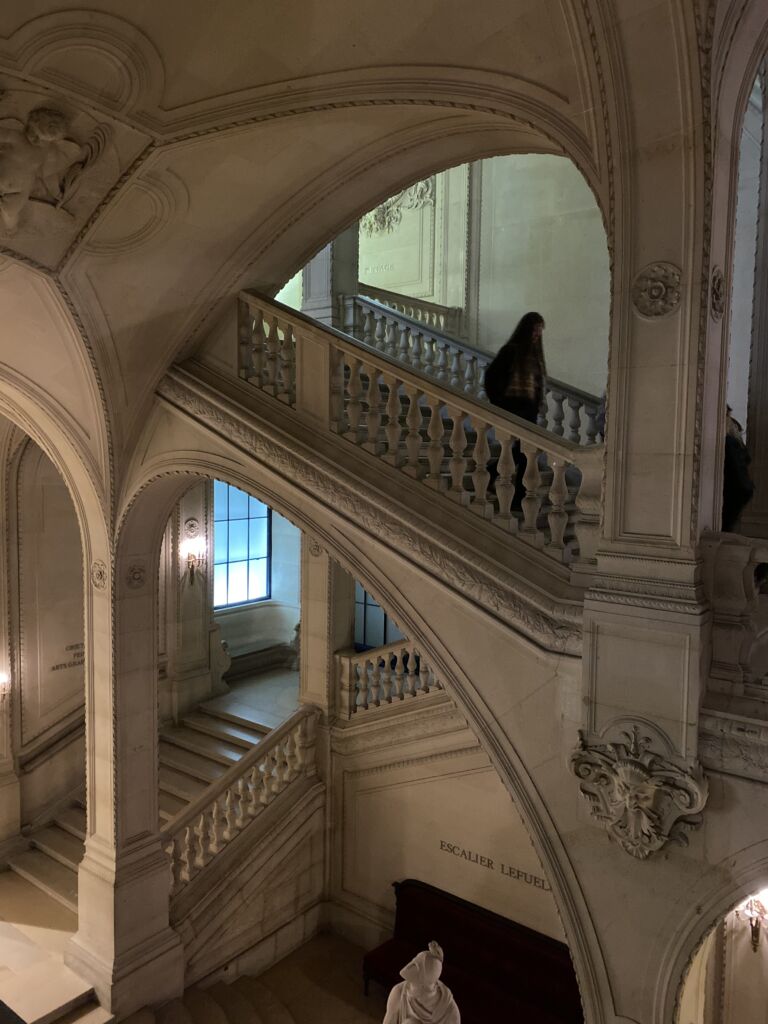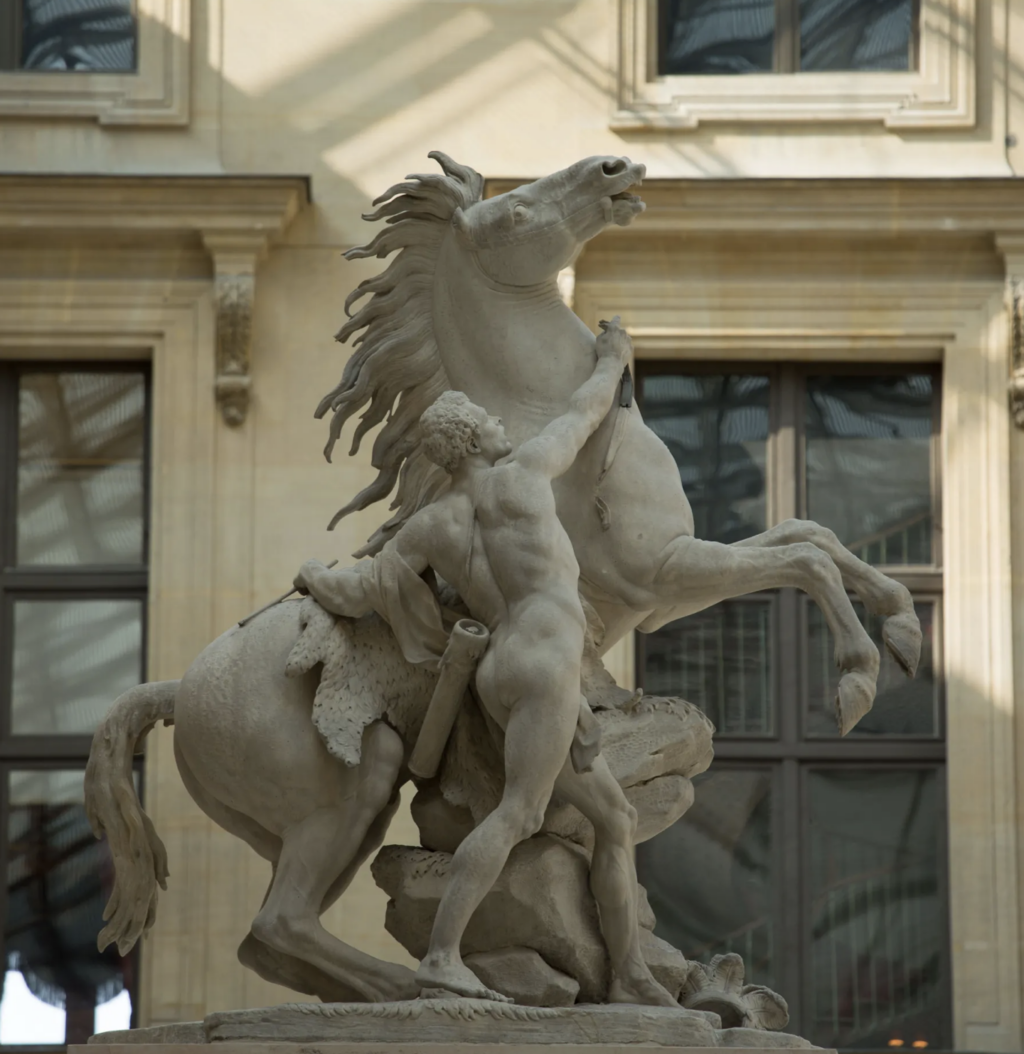Introduction: Confronting the Giant
Writing a chapter about the Louvre Museum for our guidebook 111 Museums In Paris That You Should Not Miss is both exhilarating and daunting. The Louvre is not merely a place that houses art; it symbolizes cultural achievement, representing centuries of human creativity. With 380,000 works of art and 14 kilometers of galleries, the challenge is to write about the Louvre and do it justice in a single chapter. The museum’s vastness feels like a world within itself, and I was left asking, “How can I possibly encapsulate the essence of such a monumental institution?”

The First Steps: A Meeting with the Director of Communications
My journey at the Louvre began with a meeting with the Director of Communications. Sitting across from someone with such an intimate connection to the museum was enlightening and intimidating. She suggested I start with guided visits to gain a fresh perspective on the museum. Her advice was invaluable, but it also made the task seem larger. The Louvre Museum is more than a collection of artworks; it is a vast labyrinth of history, and suddenly, I felt like I was standing at the foot of a mountain.

Louvre Night Tours: Discovering Hidden Gems with “Another Louvre”
I embarked on a series of “Another Louvre” night tours far from the crowds to gain a fresh perspective. Wandering through the museum’s halls in near silence, under the cover of night, was both eerie and thrilling. These tours unveiled hidden gems in the Louvre that many visitors might miss, and the tours also change circuits according to the guide. For instance, I explored the Napoleon III apartments and hidden rooms filled with sculptures, paintings and jewelry, spaces often overlooked during a standard daytime visit. During these quiet moments, I began to see the Louvre in a new light, discovering that its depth went far beyond the iconic Mona Lisa and Venus de Milo.

“Parcours Off” Tours: A Louvre Full of Surprises
The next revelation came through the “Parcours Off tours“, which offer thematic experiences that change throughout the year. Unfortunately, they do not offer an english transaltion but if you understand French, these tours are unexpected, blending culture and entertainment through activities like improvisational theater, yoga or making cocktails in the galleries of the Louvre. They showed me that the Louvre Museum is far from a traditional, stoic gallery—a living institution that continues evolving and engaging visitors in surprising ways. It is a side of the Louvre that I never imagined, and it broadened my view of what a museum can be.
Finding a Focus: A Friend’s Weekly Journey through the Richelieu Wing
Despite the insights gained from these tours, the challenge of writing about the Louvre still loomed large. I needed to focus and narrow down the Louvre’s vast galleries. That’s when I turned to a friend who had been visiting the Louvre weekly for 20 years. He advised exploring the Richelieu wing, a less-traveled route, which became my guiding light.

—from the gardens of Louis XIV to the grand galas of the Second Empire and the ancient cities of Mesopotamia. This became the focal point for my chapter, helping me bring a fresh perspective to the Louvre’s story.
The Richelieu Wing’s Hidden Wonders
Within the Richelieu wing, I discovered La Cour Marly, a breathtaking space that displays statues that had once been part of King Louis XIV’s leisure residence. The iconic sculptures, such as the Horses of Marly, evoked a sense of the grandeur and elegance of 18th-century French art. It was like stepping into another world, where art, history, and opulence of French royalty came together. The natural light filtering into the courtyard highlighted the beauty of these sculptures, giving them life that resonated deeply. It almost feels like you are in the gardens, the sculptures intentionally placed to make you wander in the space as you would if you were in a garden.

Another hidden treasure in the Richelieu wing is La Cour Puget, named after the famous sculptor Pierre Puget. The dramatic baroque masterpieces, such as Perseus, Andromeda, and Milo of Croton, were more than just visually stunning—they conveyed powerful moral messages. These sculptures told stories of human pride, folly, and downfall, adding a narrative depth to the artwork that gave new meaning to the Louvre’s collection. The Richelieu wing, often overlooked by visitors, became the heart of my chapter, allowing me to show a more intimate side of the Louvre.


Writing the Louvre: Crafting a Narrative Beyond the Obvious
Writing about the Louvre, I realized the challenge wasn’t just about cataloging its art or recounting its history. It was about capturing the spirit of the Louvre, a place where history, art, and culture converge. The goal was to offer a fresh perspective, allowing readers to experience the museum differently. The Louvre is more than just a series of galleries; it’s a living entity that continues to inspire, surprise, and evolve.
Conclusion: The Louvre’s Endless Inspiration
When I finished writing the chapter for 111 Museums In Paris That You Should Not Miss, I realized that no single piece of writing can fully capture the Louvre Museum. It’s impossible to experience it in just one visit or a single chapter. However, by focusing on the lesser-known parts of the museum, like the Richelieu wing and its hidden courtyards, I could offer a narrative that went beyond the well-trodden paths. Writing this chapter wasn’t just about describing the art; it was about sharing the awe and wonder that the Louvre inspires. The Louvre Museum remains a place where art and history converge, a testament to the human capacity for creation, and it will continue to inspire those who explore its depths for generations to come.

Questions: If you were to create your own personal ‘Parcours Off’ tour of the Louvre, which theme would you choose, and why?
In a future chapter, I will delve into a new subject: exploring the ateliers of artists in Paris. It promises to be an enthralling journey through art, the lives of artists, and their neighborhoods. Stay tuned.
“111 Museums in Paris That You Shouldn’t Miss” guidebook is available at the Louvre and in the US, UK, France in Museums, your local bookstore, or buy online from amazon.com
Further Reading
-

Discovering the Louvre: Secrets and Stories from Paris’ Iconic Museum
Stepping into the world of Parisian museums felt like a leap into the unknown. Our project, "111 Museums in Paris That You Should Not Miss," led us to an unexpected and enlightening journey with the Louvre. Read on to uncover the hidden gems and intriguing stories beyond the Mona Lisa.
Read more
-

“111 Museums in Paris That You Should Not Miss”: Who Does What?
Before starting to work on our guidebook "111 Museums in Paris You Should Not Miss," James and I divided our tasks. I was excited but anxious about which museums we'd cover. The experience taught us a lot and led to surprising discoveries. Want to know more about our journey? Read the full story!
Read more


